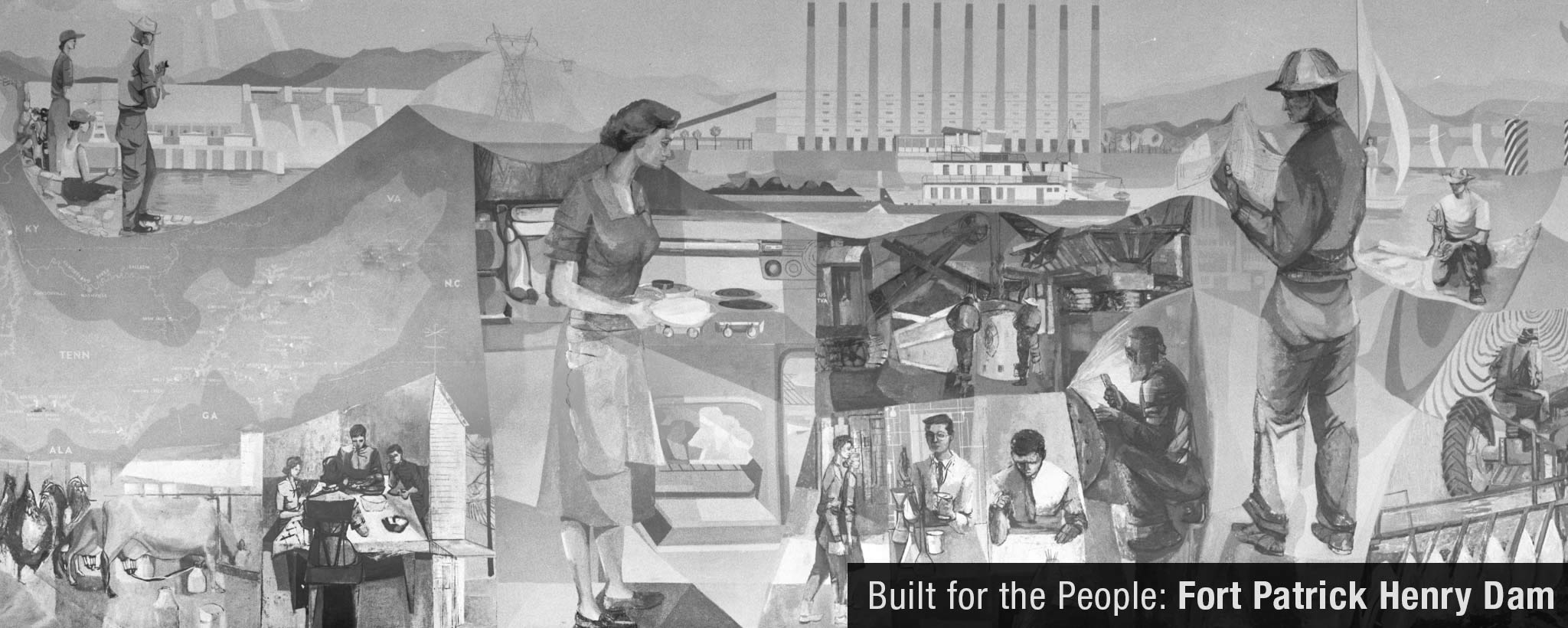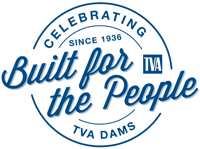
Art for the People
In its early days, TVA valued form as well as function. It even hired a staff artist, Robert Birdwell, to capture its work on canvas. His work adorns the visitor center at Fort Patrick Henry Dam.
When most folks think of TVA, public art is not the first thing that comes to mind. However, the agency was quite progressive when designing its public spaces, and gave careful consideration to the aesthetics of its installations as well as the function.
All of our TVA’s hydro facilities have the phrase “Built for the People” prominently displayed for all to see. This phrase was often placed inside the visitors center reception room, an architectural spot for guests to be greeted and informed about TVA. This space usually held a desk for the public safety officer on duty, exhibits highlighting TVA’s work and history, restrooms and comfortable sofas and chairs for the public to relax. These visitors centers served as the face of TVA.
Throughout the 1930s and 1940s, these public spaces displayed straightforward photographic exhibits highlighting TVA’s work in flood control, navigation, fertilizer development and power generation. However, this exhibition style changed dramatically in 1953 when TVA hired Robert Birdwell to serve as staff artist.
A Modern Artist for a Modern Agency
A Knoxville native, Birdwell entered the Army Air Corps fresh out of high school in 1943. While stationed in Madison, Wisconsin, he began his study of painting through the University of Wisconsin’s extension service. Once he returned home, he continued his formal education, graduating from the University of Tennessee in 1950 with a Bachelor’s degree of Fine Arts. He pursued his studies at the State University of Iowa, where he earned a Master of Fine Arts in 1952.
Birdwell returned to Knoxville and went to work at TVA. His style was colorful, progressive and—above all—modern. One of the first projects he worked on was a wall-sized mural located in the reception room at Norris Dam. This mural, hidden for many years, was uncovered in 2016 just as the dam was turning 80 year’s old. At the center of this artwork is a huge map of the Tennessee River watershed with the TVA facilities identified. Surrounding the watershed map are people involved in forestry and conservation work, farming, and even fishing. A boat is making its way on the river. It captured the work of TVA in great style—as all of his paintings would come to do.
From Literal to Figurative
An archetypal Birdwell canvas can be found in the Fort Patrick Henry Dam visitors center in Kingsport, Tennessee. This painting marks a shift in style for the artist. It illustrates vignettes of TVA’s role in improving the quality of life for people of the region—the Valley watershed map is still there, but so is a woman baking a pie in an electric oven.
What used to be represented through black and white photos and text—TVA’s work in recreation, navigation, energy production and economic development—is now illustrated with individuals conveying short colorful stories. In Birdwell’s TVA paintings, the Valley residents are progressive and modern, with an excellent quality of life. (Similar paintings adorn the reception rooms of Boone and South Holston Dam’s visitors centers as well as many fossil plants.)
Birdwell went on to become one of the Knoxville Seven, defined by the Knoxville Museum of Art as “an influential group of progressive artists in Knoxville who energized East Tennessee’s art scene between 1955 and 1965.” Along with Birdwell, the group included C. Kermit “Buck” Ewing, Carl Sublett, Walter Stevens, Joanne Higgs, Richard Clarke and Philip Nichols.
Robert Birdwell shared his talent with TVA for 29 years, retiring in the 1980s. He passed away in 2016, but his legacy is that he, along with the Knoxville Seven, helped establish a foothold for modern art in the Tennessee Valley region. It is only fitting that the modern, progressive painter’s work should adorn the walls of one of the most progressive government agencies to ever be created.
